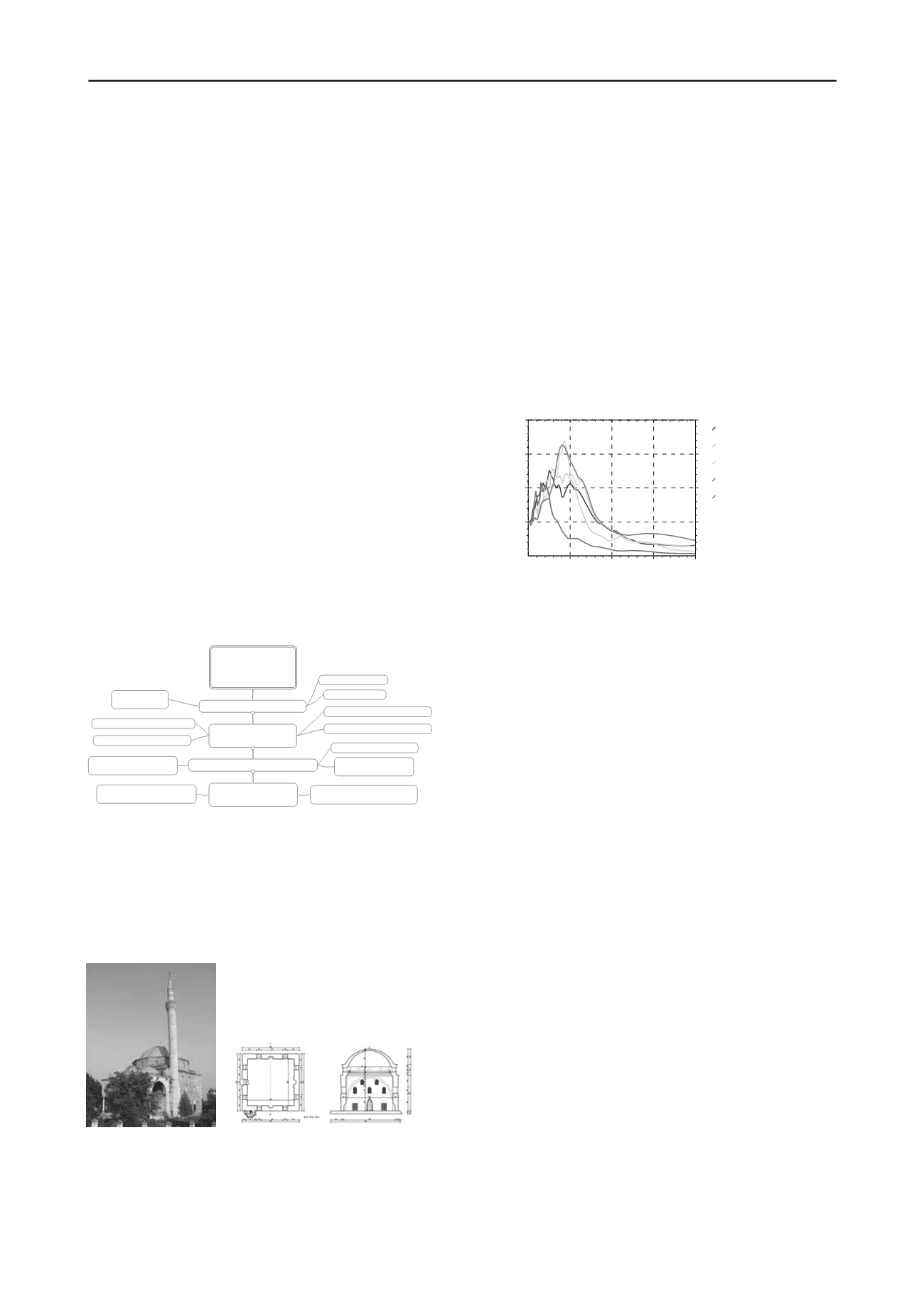
3130
Proceedings of the 18
th
International Conference on Soil Mechanics and Geotechnical Engineering, Paris 2013
Earthquakecatalog
Active fault map
Groundmotion
attenuation
Geotechnical investigation
Siteamplicationanalysis
Geophysical investigation
Microtremormeasurement
Surfacegeology
Equivalent linear static
analysis (SHAKE 2000)
Selectionof earthquake
input motions
Response spectrumat
foundation level
Accelerationtimehistoryat
fondation level
SITE RESPONSE
METHODOLOGY
(IZIIS)
Seismicity
Geodynamic
mathematical model
Seismic site response analysis
Denition of seismic
input parameters
SoilProfileNo. 1 -Layer5
NormalizedPSAfor 10%
damping -ELCENTRO
NormalizedPSAfor 10%
damping -ALBATROS
NormalizedPSAfor 10%
damping -PETROVAC
NormalizedPSAfor 10%
damping -Robic
NormalizedPSAfor 10%
damping -PARKFIELD
SpectralAcce
Period(sec)
leration / PGA
3
4
The applied methodology for definition of the seismic input
parameters in the case studies presented in this paper follows
the following steps:
The first step, Figure1 includes characterization of the
design seismic motion based on existing earthquake
catalog and seismotectonic data and the seismic hazard
through attenuation of ground motion intensity.
The second step is definition of the subsurface profile of the
studied area based on geological geotechnical, geophysical
and topographic data. Site characterization is mainly done
by geotechnical boreholes, Standard Penetration Test
(SPT), Cone Penetration Test (CPT), PS-Logging,
Refraction Microtremor (ReMi), seismic reflection and
refraction measurements and laboratory index test results
to provide engineering bedrock (Vs > 750m/s) depths.
The next step is selection of earthquake input motions
which are applied on the bedrock level and PGA
acceleration to which the earthquake motions are scaled
based on the results from the seismic hazard analysis
0
1
2
0.0
0.5
1.0
1.5
2.0
The third step is to evaluate, for each location within the
studied area, all the aspects of the seismic ground response,
namely, the elastic response spectra. The local site effects
are assessed by carrying out one-dimensional (1-D) ground
response analysis) using borehole data and shear wave
velocity profiles within the investigated area (Ordonez,
2011).
Seismic risk analysis;
Definition of seismic design parameters at different levels
(PGA, site design spectra, time histories of accelerations)
to be used in the evaluation of the existing seismic stability
of the structures.
igure 1. Flow chart of the applied methodology
CASE STUDY 1 - MUSTAFA PASHA MOSQUE
estigations related
to the local site conditions in the seismic assessment of a
re 2.
F
1
As the first case study, presented are the inv
historical structure in Macedonia: the Mustafa Pasha mosque in
Skopje, dating back to the 15th century, as shown in Figu
Figure 2. Mustafa pasha Mosque, view, plan and section
The Mustafa Pasha mosque in Skopje is located in the
Skopje valley, which was created as a result of neotectonic
movements of the surrounding structures. The geological
le as to the
amplitude and frequency content of the seismic action. Soils in
the
e local geotechnical
me
t the
se
Figure 3. Normalized response spectrum for 10% damping
rom the obtained spectra, it is seen that, for the presented
MODEL1, the amplitudes occur in the period range of 0.15 -
0.25 s, and in the period of 0.4 s (more dominant) for the
e response
alysed and
tak
eriod of the structure is 100 plus
maximum earthquake, the acceptable level of
spectral amplification factors can be used in
e amplification factors include
te. For the analysed structure,
an
se
smic assessment of a
historical structure in Macedonia: the St. Mary Peribleptos
church in Ohrid (figure 6) , dating back to the 13tn century.
characteristics of the location play an important ro
region of Skopje in Macedonia are relatively uniform
according to stiffness so that the variations along soil depth lead
to different levels of damage to structures.
The representative soil models have been defined based on
comprehensive geotechnical and geophysical investigations
arried out at the location of the mosque. The soil profile mainly
consists of sand, clay as well as marl below depth of 12m. For
the needs of this project, the effect of th
dia has been defined by analyses of the dynamic response of
representative mathematical models of the foundation soil.
The input motions at bedrock have been selected as a result
of the hazard investigations and taking into consideration the
regional seismogeological characteristics. The maximum
accelerations have been selected as amax=0.20(g) and amax
=0.30(g) which are the expected maximum accelerations a
lected location. The acceleration spectra are given in the
following figure 3.
F
analysed input excitations. The obtained results on th
spectra of the soil models have carefully been an
en into account in modelling and analysing the seismic
resistance of the mosque.
The main parameters of seismic design, the maximum
accelerations have been defined based on the results from the
seismic hazard and risk analysis under the following
assumptions:
The serviceability p
years;
For the design earthquake, the acceptable level of
seismic risk is 30-40%
For the
seismic risk is 10-20%
The obtained
probabilistic seismic hazard assessments, because, unlike the
code site factors, the proposed sit
quantification of the underlying uncertainty in the site-
dependent ground motion estima
average amplification factor DAF of 1.35 has been adopted.
For dynamic analysis, it is also necessary to know the time
histories of accelerations that reflect the characteristics of
earthquakes and the time duration of intensive excitation.
Having no records on strong motion accelerations in the region
of the investigated site, the time histories have been defined by
lection of the characteristic previously mentioned records,
whose frequency content covers the frequency range of interest
for dynamic analysis (Sesov et al., 2007).
2 CASE STUDY 2 - ST. MARY PERIBLEPTOS CHURCH
As the second case study, presented are the investigations
related to the local site conditions in the sei


